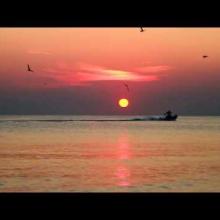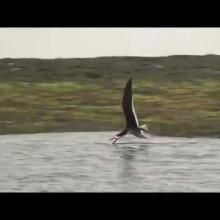

Join BirdNote tomorrow, November 30th!
Illustrator David Sibley and actor H. Jon Benjamin will face off in the bird illustration battle of the century during BirdNote's Year-end Celebration and Auction!
That’s not a distant dog barking. It’s a Black Skimmer in flight, at the Chincoteague National Wildlife Refuge in Virginia. This striking, black-and-white bird with a red bill and red feet has a most unusual way of feeding. It flies low along the surface of the water with its beak open. Closely related to terns, skimmers nest on sand islands in closely packed colonies. They depend on undisturbed islands and abundant small fish in coastal lagoons for their survival.
BirdNote®
Why the Black Skimmer Skims
Written by Dennis Paulson
This is BirdNote!
[Black Skimmer calls]
That’s not a distant dog barking. It’s a Black Skimmer in flight, at the Chincoteague National Wildlife Refuge in Virginia. [Black Skimmer calls continue] This striking black and white bird with a red bill and red feet has a most unusual way of feeding. It flies low along the surface of the water with its beak open. The bird’s long and narrow lower mandible angles down into the water. [Black Skimmer calls]
When it strikes a small fish, the shorter, curved upper bill snaps shut. The skimmer rises into the air and swallows its prey or takes it back to its young.
[If the bill hits an immovable object, the bird pivots upward and the lower mandible slides right over it, amusing to the onlooker if not to the skimmer.]
As skimmers feed by touch, they continue foraging at night, when they are less visible to their prey. [Black Skimmer calls at a colony]
Closely related to terns, skimmers nest on sand islands in closely packed colonies. They depend on undisturbed islands and abundant small fish, both characteristic of the coastal lagoons of the Atlantic Flyway. [Black Skimmer colony continued]
I’m Mary McCann.
Forage at our website anytime day or night – you’re always welcome! Today you’ll find more about Black Skimmers and the Chincoteague National Wildlife Refuge. That’s birdnote.org.
Support comes from Sasquatch Books, announcing Pacific Flyway: Waterbird Migration from the Arctic to Tierra del Fuego, a blend of photography, science writing, and storytelling.
###
Senior Producer: Mark Bramhill
Producer: Sam Johnson
Managing Editor: Jazzi Johnson
Content Director: Jonese Franklin
Bird sounds provided by The Macaulay Library at the Cornell Lab of Ornithology, Ithaca, New York. Call of individual Black Skimmer [179806] recorded by T. Parker III; calls from flock of Black Skimmer [136275] recorded by M.J. Fischer.
BirdNote’s theme music was composed and played by Nancy Rumbel and John Kessler.
© 2014 Tune In to Nature.org February 2014/2018/2020/2023/2025 Narrator: Mary McCann
ID# BLSK-01-2020-2-24 BLSK-01
https://www.fws.gov/northeast/chinco/PDF/BirdChecklist.pdf






